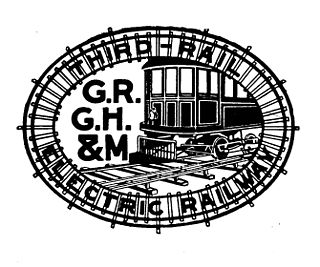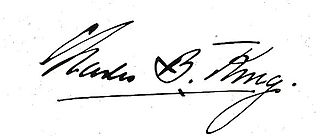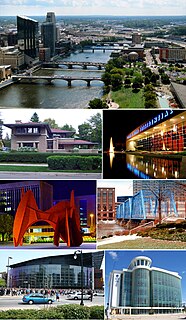
Packard was an American luxury automobile marque built by the Packard Motor Car Company of Detroit, Michigan, United States. The first Packard automobiles were produced in 1899, and the last Detroit-built Packard in 1956, when they built the Packard Predictor, their last concept car.

Ransom Eli Olds was a pioneer of the American automotive industry, after whom the Oldsmobile and REO brands were named. He claimed to have built his first steam car as early as 1887 and his first gasoline-powered car in 1896. The modern assembly line and its basic concept is credited to Olds, who used it to build the first mass-produced automobile, the Oldsmobile Curved Dash, beginning in 1901.
The Pere Marquette Railway operated in the Great Lakes region of the United States and southern parts of Ontario in Canada. It had trackage in the states of Michigan, Ohio, Indiana and the Canadian province of Ontario. Its primary connections included Buffalo; Toledo; and Chicago. The company was named after Père Jacques Marquette S.J. (1637–1675), a French Jesuit missionary who founded Michigan's first European settlement, Sault Ste Marie.
A clipper is a 19th-century fast sailing ship with three masts and a square rig.

The Argo was a short-lived United States automobile manufactured by the Argo Motor Co in Jackson, Michigan, between 1914 and 1918. The factory had been previously used by the Standard Electric Car Co to build an electric car.

West Michigan and Western Michigan are terms for an arbitrary region in the U.S. state of Michigan's Lower Peninsula. Most narrowly it refers to the Grand Rapids-Muskegon-Holland area, or more broadly to most of the region along the Lake Michigan shoreline of the Lower Peninsula, but there is no official definition for it.

The Grand Trunk Western Railroad Company is an American subsidiary of the Canadian National Railway operating in Michigan, Illinois, Indiana and Ohio. Since a corporate restructuring in 1971 the railroad has been under CN's subsidiary holding company the Grand Trunk Corporation. Grand Trunk Western's routes are part of CN's Michigan Division. Its primary mainline between Chicago, Illinois, and Port Huron, Michigan, serves as a connection between railroad interchanges in Chicago and rail lines in eastern Canada and the Northeastern United States. The railroad's extensive trackage in Detroit and across southern Michigan has made it an essential link for the automotive industry as a hauler of parts and automobiles from manufacturing plants.
The De Vaux was an automobile produced by the De Vaux-Hall Motors Company of Grand Rapids, Michigan, and Oakland, California.
The Continental De Vaux was an automobile produced by the Continental-De Vaux Company in Grand Rapids, Michigan.
The Grand Rapids and Indiana Railroad at its height provided passenger and freight railroad services between Cincinnati, Ohio and the Straits of Mackinac in Michigan, USA. The company was formed on January 18, 1854.

SS Milwaukee Clipper, also known as SS Clipper, and formerly as SS Juniata, is a retired passenger ship and automobile ferry that sailed under two configurations and traveled on all of the Great Lakes except Lake Ontario. Along with the SS Keewatin, Milwaukee Clipper is one of only two passenger steamships left on the Great Lakes. The vessel is now docked in Muskegon, Michigan.
The Gem was an automobile manufactured in both Jackson, Michigan and Grand Rapids, Michigan by the Gem Motor Car Company from 1917 to 1919. The company was incorporated in December 1917, and early the next month it was announced that capitalization was to be $250,000, with $150,000 yet to be issued. The Gem was a light, assembled car with a four-cylinder G.B.&S. engine. Originally the plan was to acquire the complete chassis and bodies and complete the assembly of the cars in Grand Rapids. Gem planned to make some of the components itself eventually, though this appears not to have occurred. Only two models were produced, a 5-passenger touring car, selling for $845, and a light delivery van.
The Hackett was an automobile built in Jackson, Michigan, United States, by the Hackett Motor Car Company from 1916 to 1919.

The Harrison was an American automobile built in Grand Rapids, Michigan originally by the Harrison Wagon Company from 1905 through 1906. The company was renamed to the Harrison Motor Car Company in 1907.

The Grand Rapids, Grand Haven and Muskegon Railway was an electric interurban railway that operated in west Michigan from 1902 until 1928.

Ramona Park was an amusement park located in the city of East Grand Rapids, Michigan between 1897 and 1955. The Park included a double track wooden roller coaster, a theater pavilion, a ridable miniature railway and boat livery.

The Jackson Automobile Company was an American Brass Era automobile manufacturer located in and named for Jackson, Michigan. The company produced the Jackson from 1903 to 1923, as well as the 1903 Jaxon steam car and the 1904 Orlo.

Charles Brady King was an American engineer and entrepreneur remembered as an automotive pioneer, artist, etcher, musician, poet, architect, mystic, industrialist and inventor.

Haskelite Manufacturing Corporation (1917–1956) was a conglomerate of Michigan – based companies. It was located on Broadway Avenue in Grand Rapids, Michigan. They manufactured haskelite plywood for a wide variety of applications and vehicles. Their office headquarters were located in Chicago, Illinois. The Grand Rapids corporation was a spin-off from the Haskell Manufacturing Company in Ludington, Michigan. It was a factory twice the capacity at over 100,000 square feet and designed to make up to ten times as much plywood per day as the Ludington facilities. The plywood at the beginning was needed for World War I military airplane body parts. The plywood later was used in houses, buildings, automobiles and ship construction. Different styles and types of plywood were made for particular niches. The corporation made the largest plywood ever produced, which was used in constructing a particular US Navy boat. A well known use for the Haskelite plywood produced at the Grand Rapids facilities was for the construction of the Spirit of St. Louis, Charles Lindberg's plane.














